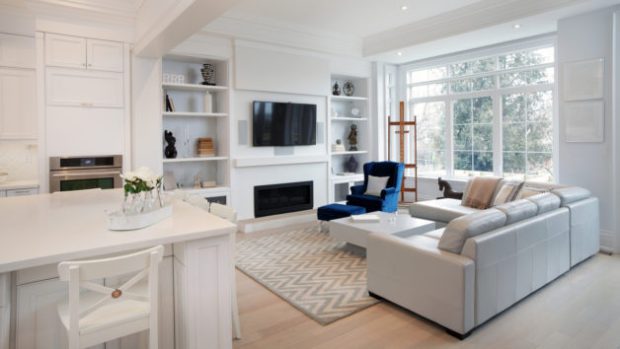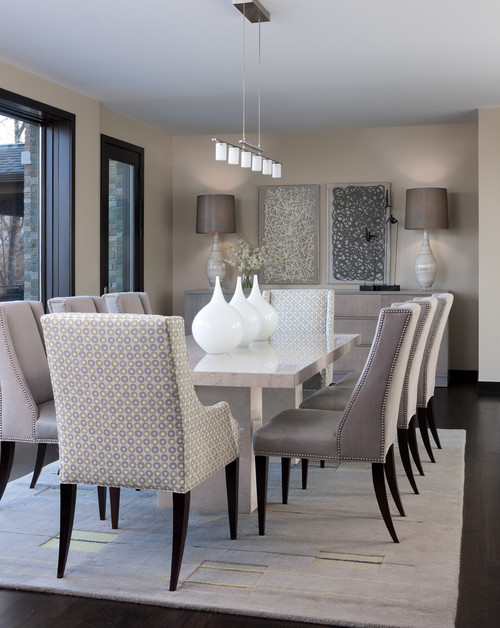By Margaret Heidenry

With so many decor styles out there, it can be hard to stick with just one. Modern, rustic, shabby chic, traditional—deciding on the vibe you want for your home can be downright confusing. But here’s the great thing about interior design: Many of these styles overlap, and can actually work really well together. The design world uses the term “transitional style” to describe the type of design that melds two different aesthetics—modern and traditional—into the same room. So how can you bring transitional style into your home? Our experts break it down for you.
Defining transitional style
The key to achieving this style is balance. Transitional style welcomes disparate styles—the traditional and the modern, the feminine and the masculine—in the same space. It’s a classic, clean look that’s reinvigorated by mixing in contemporary furniture, rugs, and accessories, according to Ellie Thompson, CEO of Venyou, an online platform that lists private homes and estates for events. An angular, modern dining table surrounded by traditional upholstered chairs is a typical example of transitional design. A rule of thumb: You want the decor to be inviting and accessible, not veering too far into one trend or another.

Photo by Ashley Campbell Interior Design—A modern marble table is paired with more relaxed, upholstered dining chairs.
As with any design style, there are unofficial rules to get the look. You can best achieve the mix-and-match transitional style in your home by choosing pieces that follow these guidelines.
Element No. 1: Beige is your friend
Neutral tones are the hallmark of transitional style, according to Thompson. Go for an unsaturated palette of white, cream, beige, tan, gray, or light brown. A simple neutral backdrop for the walls, flooring, cabinets, and large furniture will make the room feel timeless.
Element No. 2: Mix textures
Transitional style embraces different materials that have the same color but that give texture to the space. “Whether it be stone, wood, or leather, transitional style isn’t married to one type of material,” says Thompson. “Using a couple different textures will help you achieve an elegant but modern look.” She suggests incorporating such textures as chrome, gold, wood, glass, fabric, and faux fur into every room of your home.
Element No. 3: Use antiques strategically
Balance out an otherwise contemporary room with an antique statement piece. This will give the room depth and show off your curating skills. “Nothing makes a room feel more modern,” says interior designer Mark Cutler of Los Angeles. “The more sleek the space, the more rustic and worn the antique should be,” he says.
Element No. 4: Use bold accents sparingly
“Don’t overdo it!” says Thompson. Keep it simple by picking a couple loud pieces that accent the room but don’t clutter it. Patterns are used sparingly and tend toward geometrics. “And window treatments will be simple, with sleek lines instead of fussy or complex designs,” says Griffin.

Photo by Martha O’Hara Interiors—Yellow accessories in a transitional living room add interest but don’t overpower.
Element No. 5: A contemporary rug is a must
Transitional furnishings will almost always be partnered with a contemporary rug—think solid, geometric or animal prints—rather than a traditional rug that’s floral, paisley, or oriental, says Griffin. “This is a simple way to touch on transitional style that doesn’t require a complete redesign of your home.”
Element No. 6: Choose modern art that makes a statement
“Keep it big and bold for a greater impact, instead of hanging lots of smaller pieces,” says Griffin. Art should have a contemporary look, in terms of style and colors—abstract works, graphic prints, and photography are best.
Element No. 7: Rely on classic lines
Stick to furniture, tables, and beds that have a sophisticated shape with simple, sophisticated lines, as opposed to pieces that are rounded and ornate. Transitional furniture will be comfortable but boast straighter lines.
“Square off everything,” says Tracy Kay Griffin, lead designer at Express Homebuyers. That means that in choosing a traditional element, you avoid curves and ornate detail, and make sure it has straighter lines, to minimize detail. “For example, doorknobs could be straight levers as opposed to round knobs, and sinks may have a rectangular shape.”
The transitional aesthetic requires the seamless marrying of several traditional pieces with true contemporary pieces. Essentially, this means that your home should be a sophisticated yet livable home, full of beloved items and sensible furniture that can last a lifetime.